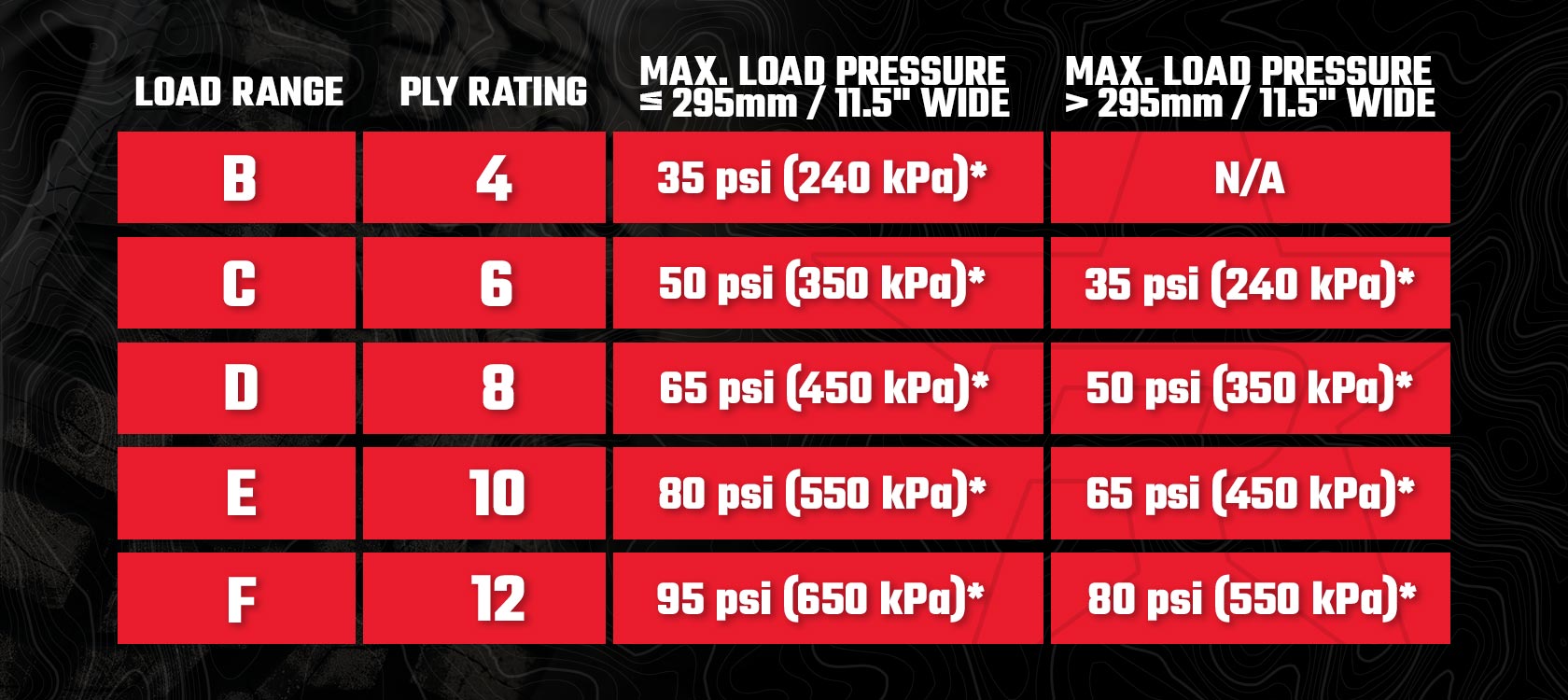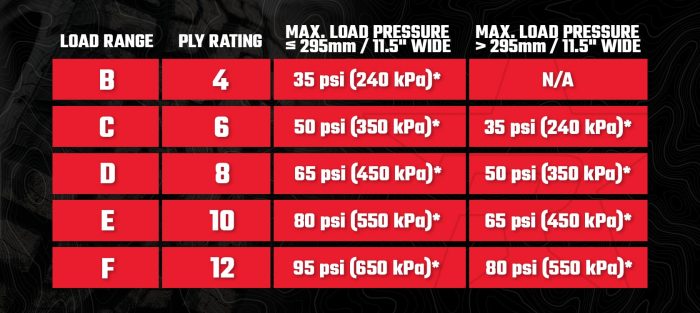Light Truck Tire Load Ratings: Your Comprehensive Guide to Safety and Performance

Light Truck Tire Load Ratings: Your Comprehensive Guide to Safety and Performance
For anyone who drives a pickup truck, SUV, or van classified as a light truck, understanding tire load ratings isn’t just a recommendation—it’s a critical safety imperative. These seemingly cryptic numbers and letters on your tire’s sidewall dictate the maximum weight a single tire can safely carry under specified conditions. Ignoring them can lead to catastrophic tire failure, compromised vehicle handling, reduced fuel efficiency, and even legal repercussions. This comprehensive guide will demystify light truck tire load ratings, empowering you to make informed decisions for your vehicle’s safety, performance, and longevity.
The Foundation: What Are Light Truck Tire Load Ratings?
Light truck (LT) tire load ratings are a standardized system designed to communicate a tire’s maximum weight-carrying capacity. Unlike passenger car (P) tires, which are designed for lighter loads and more forgiving handling, LT tires are engineered to handle the heavier payloads, towing demands, and often more rugged conditions associated with trucks and commercial vehicles.
The primary components of a load rating system include:
- Load Index: A numerical code that corresponds to the maximum weight a tire can support when properly inflated. A higher load index number signifies a greater load capacity.
- Speed Rating: An alphabetic code indicating the maximum speed at which the tire can carry its rated load under specified conditions. While crucial for overall tire performance, our focus here remains on load.
- Load Range (Ply Rating Equivalent): An older system, often still used, represented by letters (e.g., C, D, E, F) that historically correlated to the number of plies (layers) in the tire’s construction and, more importantly, to a specific maximum inflation pressure and load capacity. While modern tires don’t necessarily have that many actual plies, the Load Range still indicates a tire’s robustness and pressure capability.
Understanding these elements is fundamental to ensuring your light truck operates safely, whether you’re hauling construction materials, towing a boat, or simply commuting.
Decoding Your Tire’s Sidewall: A Practical Guide
Locating and interpreting your tire’s load rating information is straightforward once you know where to look. Here’s a typical example you might find on an LT tire sidewall:
LT265/75R16 123/120Q E
Let’s break down the relevant parts for load ratings:
- LT: This prefix immediately identifies the tire as a "Light Truck" tire, designed for more demanding applications than passenger (P) tires.
- 265/75R16: This is the tire size:
265: Tread width in millimeters.75: Aspect ratio (sidewall height as a percentage of width).R: Radial construction.16: Rim diameter in inches.
- 123/120: This is the Load Index.
123: Refers to the load capacity when the tire is used in a single application (one tire per wheel position).120: Refers to the load capacity when the tire is used in a dual application (two tires per wheel position on the same axle, typically found on the rear of some heavy-duty trucks). Always refer to the single application number unless your vehicle explicitly uses dual rear wheels.
- Q: This is the Speed Rating (in this case, 99 mph).
- E: This is the Load Range.
The Load Index (123/120 in our example) is the most precise indicator of a tire’s maximum weight capacity. You’ll need to consult a Load Index chart (like the one provided later) to convert this number into pounds or kilograms.
Load Index vs. Load Range: Understanding the Nuances
While both Load Index and Load Range provide information about a tire’s capacity, they do so differently:
- Load Index: This is the modern, precise method. Each numerical Load Index corresponds to a specific maximum load capacity in pounds or kilograms. It’s the most accurate way to determine how much weight a tire can carry. For instance, a Load Index of 123 translates to 3,417 lbs (1,550 kg) per tire.
- Load Range: This is a letter-based system that historically related to the "ply rating"—the number of cotton plies in a tire’s construction. Today, it primarily indicates the tire’s strength and, crucially, its maximum allowable inflation pressure. A higher Load Range (e.g., E vs. D) generally means a tire can handle more pressure and thus a higher load.
- Load Range C: Typically 6-ply rated, max pressure 50 PSI (pounds per square inch).
- Load Range D: Typically 8-ply rated, max pressure 65 PSI.
- Load Range E: Typically 10-ply rated, max pressure 80 PSI.
- Load Range F: Typically 12-ply rated, max pressure 95 PSI.
- Load Range G: Typically 14-ply rated, max pressure 110 PSI.
While a higher Load Range generally implies a higher Load Index, it’s the Load Index number that gives you the exact weight capacity. Always ensure the tire’s Load Range meets or exceeds your vehicle’s requirements, as this dictates the pressure you can run to achieve the tire’s full load capacity.
Matching Tires to Your Vehicle’s Needs and Usage
The single most important rule when selecting light truck tires is to never choose a tire with a lower load rating than what was originally specified by your vehicle manufacturer. This information is usually found on a placard located on the driver’s side door jamb, glove compartment, or owner’s manual. This placard will specify the original equipment (OE) tire size, recommended inflation pressures, and the required load rating.
Consider these factors when choosing new tires:
- Vehicle Placard: This is your primary source of truth. Adhere strictly to its recommendations for minimum load index and load range.
- Payload and Towing: If you frequently haul heavy loads or tow trailers, ensure your tires’ combined load capacity (per axle) exceeds the maximum gross axle weight rating (GAWR) of your vehicle. Remember, the tires must be able to support not just the vehicle’s weight but also its maximum payload (passengers, cargo) and tongue weight from a trailer.
- Vehicle Modifications: Lifting your truck or making other significant suspension changes can affect weight distribution and tire demands. Consult with a reputable tire professional or modification specialist.
- Single vs. Dual Rear Wheels: As noted in the decoding section, some heavy-duty light trucks use dual rear wheels. Ensure you use tires designed for dual applications if your vehicle requires them, and always use the correct load index for that configuration.
The Risks of Incorrect Load Ratings
Using tires with insufficient load ratings is incredibly dangerous and can lead to a host of problems:
- Safety Hazards:
- Blowouts: Overloaded tires generate excessive heat, leading to tread separation and catastrophic blowouts, especially at highway speeds.
- Loss of Control: Under-inflated or overloaded tires deform excessively, reducing stability, braking effectiveness, and steering response.
- Reduced Tire Life: Overloading accelerates wear and tear, leading to premature tire failure and the need for costly replacements.
- Poor Handling and Ride Quality: The tires will flex excessively, resulting in a spongy, unstable ride and compromised handling characteristics.
- Vehicle Damage: The additional stress can strain suspension components, axles, and even the vehicle’s frame over time.
- Legal and Insurance Issues: Operating an overloaded vehicle can be illegal, potentially leading to fines. In the event of an accident, your insurance claim could be denied if it’s determined that incorrect tires or overloading contributed to the incident.
Best Practices for Tire Selection and Maintenance
- Always Verify: Before purchasing new tires, double-check your vehicle’s door jamb placard for the recommended OE tire size, load index, and load range.
- Match or Exceed: Select tires with a load index and load range equal to or greater than the manufacturer’s specifications. Never downgrade.
- Proper Inflation is Key: Tire load capacity is directly tied to inflation pressure. Always inflate your LT tires to the pressure recommended by your vehicle manufacturer (found on the door jamb placard), especially when carrying heavy loads or towing. Under-inflation is a leading cause of tire failure.
- Don’t Mix: Avoid mixing tires with different load ratings on the same axle, as this can lead to uneven wear and unpredictable handling. Ideally, all four tires should have matching load ratings.
- Regular Inspections: Periodically inspect your tires for signs of wear, damage, or bulging, which could indicate stress from overloading or under-inflation.
- Rotation and Alignment: Regular tire rotation helps ensure even wear across all tires, while proper wheel alignment prevents irregular wear patterns that can compromise a tire’s integrity.
Common Light Truck Tire Load Index Chart
This table provides a reference for common Load Index numbers and their corresponding maximum load capacities per tire in single applications. Always refer to your tire’s actual sidewall and your vehicle’s placard.
| Load Index | Max Load (lbs) | Max Load (kg) |
|---|---|---|
| 100 | 1,764 | 800 |
| 101 | 1,819 | 825 |
| 102 | 1,874 | 850 |
| 103 | 1,929 | 875 |
| 104 | 1,984 | 900 |
| 105 | 2,039 | 925 |
| 106 | 2,094 | 950 |
| 107 | 2,149 | 975 |
| 108 | 2,205 | 1,000 |
| 109 | 2,271 | 1,030 |
| 110 | 2,337 | 1,060 |
| 111 | 2,403 | 1,090 |
| 112 | 2,469 | 1,120 |
| 113 | 2,535 | 1,150 |
| 114 | 2,601 | 1,180 |
| 115 | 2,679 | 1,215 |
| 116 | 2,756 | 1,250 |
| 117 | 2,833 | 1,285 |
| 118 | 2,910 | 1,320 |
| 119 | 2,998 | 1,360 |
| 120 | 3,086 | 1,400 |
| 121 | 3,197 | 1,450 |
| 122 | 3,307 | 1,500 |
| 123 | 3,417 | 1,550 |
| 124 | 3,527 | 1,600 |
| 125 | 3,638 | 1,650 |
| 126 | 3,748 | 1,700 |
| 127 | 3,858 | 1,750 |
| 128 | 3,968 | 1,800 |
| 129 | 4,079 | 1,850 |
| 130 | 4,189 | 1,900 |
| 131 | 4,299 | 1,950 |
| 132 | 4,409 | 2,000 |
Practical Advice and Actionable Insights
- Consult Your Placard First: Always start your tire search by checking the sticker on your driver’s side door jamb for the manufacturer’s recommended tire size and load ratings.
- Don’t Guess on Pressure: Your tire’s maximum load capacity is only achieved at its maximum recommended inflation pressure for that load. For daily driving, follow your vehicle’s placard for optimal pressure.
- When in Doubt, Ask a Pro: If you’re unsure about the correct load rating for your specific application, especially if you’re upgrading or modifying your vehicle, consult with a certified tire specialist.
Frequently Asked Questions (FAQ)
Q1: Can I put passenger (P) tires on my light truck?
A1: Generally, no. Passenger tires are not designed to carry the heavy loads or withstand the stresses typically placed on light trucks. Using P-rated tires on a vehicle designed for LT tires can be extremely dangerous, leading to premature wear, blowouts, and compromised handling.
Q2: My new tires have a higher load index than my old ones. Is that okay?
A2: Yes, it’s generally safe and often beneficial to choose tires with a higher load index than your vehicle’s minimum requirement, especially if you frequently carry heavy loads or tow. This provides an added margin of safety and durability. However, ensure the physical size fits without rubbing.
Q3: Does a higher Load Range (e.g., Load Range E) always mean a tire can carry more weight?
A3: While a higher Load Range generally indicates a more robust tire capable of higher inflation pressures and thus higher loads, it’s the specific Load Index number that gives you the precise maximum weight capacity. Always refer to the Load Index for the exact figure.
Q4: How does tire pressure relate to load capacity?
A4: Tire load capacity is directly dependent on inflation pressure. A tire’s maximum load rating is achieved only when inflated to its maximum recommended pressure (as indicated on the tire sidewall or vehicle placard for specific loads). Running under-inflated tires severely reduces their load capacity and increases the risk of failure.
Q5: What’s the difference between "maximum load" on the tire sidewall and my vehicle’s "payload capacity"?
A5: The "maximum load" on the tire sidewall is the absolute most weight that single tire can carry. Your vehicle’s "payload capacity" (found in your owner’s manual or door jamb) is the total amount of weight (passengers + cargo + tongue weight from a trailer) your entire vehicle can safely carry. You must ensure that the sum of your tire’s capacities on each axle exceeds your vehicle’s Gross Axle Weight Rating (GAWR).
Conclusion
Understanding light truck tire load ratings is more than just knowing a few numbers; it’s about ensuring the safety, performance, and longevity of your vehicle. By correctly interpreting load indexes and load ranges, matching tires to your specific vehicle and usage, and maintaining proper inflation, you can prevent dangerous tire failures, optimize your truck’s capabilities, and protect your investment. Treat your tires as the critical safety components they are, and they will reliably carry you and your cargo for miles to come.

